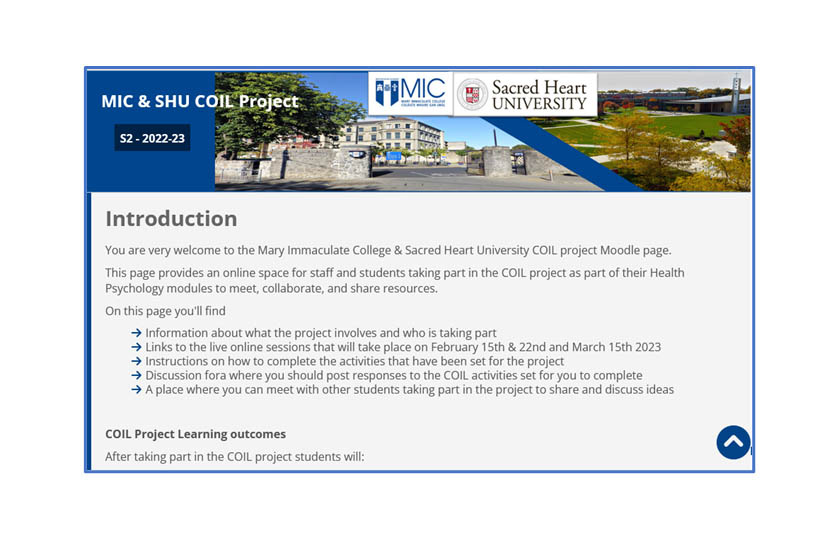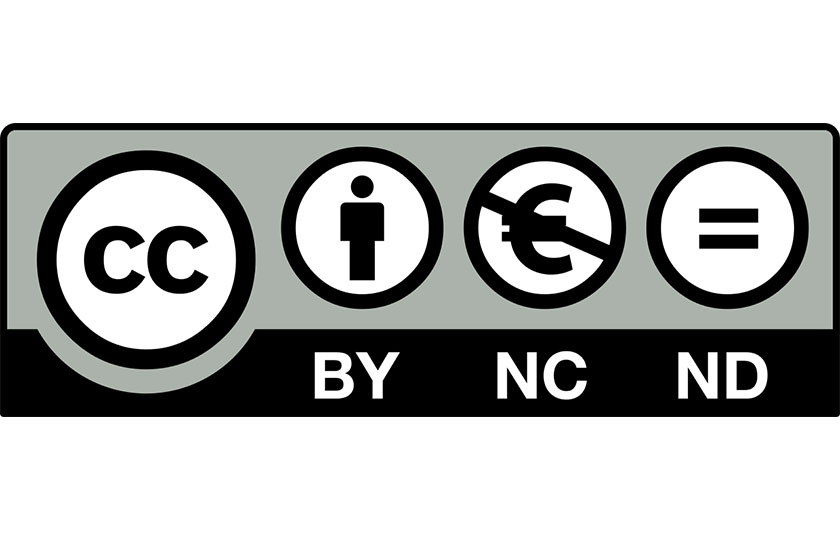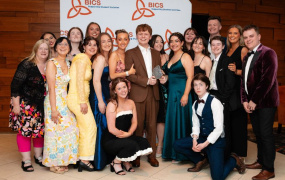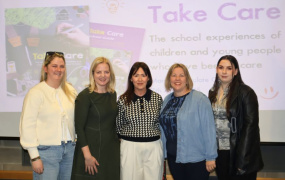Developing Authentic Assessment and Enhancing Student Engagement through a Collaborative Online International Learning (COIL) Exchange
Collaborative Online International Learning (COIL) Exchange
| Lecturer - Dr Niamh Higgins |
|---|
| Discipline - Psychology |
| Subject - Health Psychology |
| Level - Undergraduate BA Psychology, B Ed in Education & Psychology |
| Class Size - 25-30 students |
| Mode of Delivery - In-person |

This case study shares my experience of creating an authentic assessment aimed at enhancing and sustaining student engagement in my health psychology module. I wanted my approach to assessment to be one that would challenge students to think about how the material we discuss in class is applied in a real-world context. I further embedded this approach into an international teaching collaboration, and in so doing sought to develop my students as global citizens.
Rationale
I wanted to enhance student engagement in my health psychology module and to introduce more opportunities for active learning through class discussion and interaction.
My first step in establishing a new approach to assessment was to identify and consider the approaches to assessment of my international peers who teach health psychology. As one of the topics focused upon in the health psychology module that I teach is health-related behaviour (e.g., eating a healthy diet, being physically active), I wanted students to understand, not only the psychological theories and research findings relating to why we eat particular foods or have higher or lower levels of physical activity, but how we can apply this knowledge and understanding in everyday life to enhance physical health.
On reviewing Professor Jane Ogden’s (University of Surrey) health psychology module outline online, I reached out to her and she kindly shared with me the assessment brief she uses in her module. This assignment, which I adopted for my module, requires students to create a health information resource, targeted at a specific audience (e.g., the general public, healthy individuals, a patient group). The resource should contain practical information on how to enhance and improve physical health by changing an existing health behaviour or developing a new one (e.g., eating more fruit and vegetables or establishing and maintaining a regular exercise routine). In addition, students were asked to write a commentary that outlines the theories and research findings that informed the design of their resource. Key to successful completion of the assignment is a clear understanding of the psychological determinants of behaviour that are being targeted and how best to target them.
I adapted the original assessment brief shared with me by introducing student choice to the format in which they present their resource. The original assessment asks students to prepare a written leaflet. I introduced the option of creating a short video so as to align the assignment with principles of Universal Design for Learning. As all students may not have been familiar with how to create a video, I made resources available to them on how to record a video. Informed by the digital learning literature, and with tips from Professor Ogden on how best to present the assignment to students, I introduced learning activities in class and online in the weeks prior to the assignment submission date. These focused on identifying relevant empirical research findings, understanding the importance of an evidence-based approach, and engaging in critical analysis. The purpose of these low-stakes activities was to support students in developing and enhancing the skills they needed to design and create their own resource. For example, one task presented students with the opportunity to work together in small groups to review some existing health information resources, and challenged them to consider what theory or research findings might have informed the information presented, what works well in the resource, and how it might be improved upon.
To further enhance student engagement in the module and increase students’ intercultural competence, I developed this approach further by incorporating it into a Collaborative Online International Learning (COIL) exchange with my collaborator Professor Lisa Smith (Sacred Heart University, United States of America). This exchange focused on the sharing of cultural perspectives and brought together students studying health psychology at Mary Immaculate College and at Sacred Heart University. Students at both higher education institutions engaged with similar health psychology course material in their respective modules and collaborated on the learning activities described above before independently creating their own resource. The shared learning environment for our COIL exchange was presented via the learning management system ‘Moodle’, as seen below. This international collaboration provided the opportunity for students to consider international perspectives and encouraged them to think about how their learning applied at a global level.

What Worked and Why?
The assignment is one that students have engaged well with. The non-graded learning activities I introduced (as described above) to scaffold student learning and to support their development of the skills needed to complete the assignment, successfully prompted class discussion and engagement. In turn, this helped to achieve greater active learning on the module. The learning activities also helped to ensure that students were clear on how they should go about undertaking the assignment. This approach enabled me to identify areas of confusion for students when they were completing the learning tasks and gave me the space to provide clarifications. In giving students a choice as to how to present their resource (written leaflet or video) they had the option of exploring an alternative means of communication and the opportunity to gain new skills.
The international learning exchange provided a valuable opportunity for students to explore cultural influences and global perspectives on health psychology. In terms of the international elements of this approach, we found that ice-breaker tasks that consisted of staff and students preparing short videos to introduce themselves, worked well in allowing students to get to know their international collaborators. Please click here to see the brief for creating this ice-breaker video and click here for the guidelines for the group activity. Additionally, having students approach the same task from different cultural perspectives, helped all the students to see how theories and concepts might work and be understood differently around the world. In this way, both staff and students were given additional cultural reference points from which to work and think.
Any Problems or Issues that Arose from this Approach?
In a small number of instances, students focused mostly on the health information resource component of the assignment and directed less of their attention and efforts to the commentary component in which they were required to outline their rationale for the information included and how it was presented. Clearly communicating the objective of the assignment, and engaging students in the learning activities is important to ensure that students understand the aims of the assignment. Students should be encouraged to produce an evidence-based and theory-driven resource that is suitable for a lay audience and a commentary that makes clear how theory and evidence have informed the design of the resource. They should be discouraged from producing a resource that looks well but which does not reflect the student’s learnings.
International time differences and timetabling were a consideration for the international collaboration. It can be a challenge to identify a suitable time for online classes that works for students at both institutions. Time is also an important consideration both in terms of having sufficient lead-in time to prepare for the collaboration and also with respect to balancing other work commitments whilst the collaboration is ongoing during term. As one might expect, this is most notable in the first year of running the collaboration. My collaborator and I engaged in a three-week online training program at the point of embarking on the collaboration and had regular meetings in the months prior to our collaborative online sessions.
The gradual introduction of the learning activities that support students in developing the skills they need to create their own resource requires planning. Allow sufficient time to present the learning activities in turn, over a number of weeks, as well as time for students to complete them before the assignment submission deadline.
With respect to the international exchange, identifying appropriate applications to support communication and collaboration is amongst the first steps of designing the exchange. Students will need to be supported in the use of applications that they are not familiar with (including Learning management systems that differ to what is used at their home institution). Allow a number of months to plan for the collaboration and complete appropriate training. Further information on how we implemented this COIL exchange is available in the journal article I published with my collaborator which can be accessed here.
When embedding principles of Universal Design for Learning in this practice, you should consider what additional supports and resources students may need (e.g., information on how to record a video, if that’s not something they have done before).
I embarked on a professional development journey for which the goal was to introduce authentic assessment in my health psychology module to enhance my teaching practice and increase student engagement and active learning. Through engagement with colleagues (in my own institution and internationally), I developed a new approach to teaching and assessment in my module. The introduction of assessment relevant learning activities to scaffold student learning and the use of authentic assessment, as described above, have been effective in achieving my professional development goal. Engaging in an international teaching collaboration was not something that I had considered when I set out to design an authentic assessment.
When the invitation to collaborate on a COIL exchange presented, I used the opportunity to build further on my newly developed approach to teaching and assessment. It proved helpful to have this new approach to draw on in developing the COIL exchange and it has been satisfying to reflect on how this approach has developed and evolved over time. My COIL collaborator and I will rest the international collaboration for the current academic year while we take time to reflect further on what has worked well and what might be improved upon in future COIL exchanges. Developing the collaboration further by introducing additional learning activities and shared teaching via guest lectures on one another’s modules is something I plan to pursue. The teaching and assessment approach I’ve described here has been applied to one half of my health psychology module. I plan to consider ways of introducing authentic assessment in the other half of the module within the short term.
To find out more about engaging in a Collaborative Online International Learning Exchange please visit the SUNY COIL website here.
Except where otherwise noted, content on the LEAD section of this website is licensed under a Creative Commons Attribution 4.0 International licence.
COIL Activity 1: Introduction Video (Ice-breaker Activity)
Mary Immaculate College & Sacred Heart University COIL Project Spring 2023
For this task you are asked to record a 2-minute video introducing yourself to fellow students at MIC and SHU who are also taking part in the COIL project.
You should begin the video by introducing yourself. Tell us your name, whether you are an MIC or SHU student and what program you are studying. Next, tell us (1) a fun fact or something interesting about your home town or state (USA)/county (Ireland) or (2) about a hobby or past-time you enjoy.
Record and post your 2-minute video on the COIL project Moodle page. The deadline for posting your video is Tuesday 14th February at 2pm (Ireland) and 9am (USA). The videos that have been recorded by others will become available for you to view when you post your video. All students are encouraged to watch 4 or more videos posted by students who don’t attend the same college as you, so if you are a SHU student we encourage you to watch videos posted by MIC students and vice versa. All students should then leave one comment on one other video (for example, you can choose to say hello, tell someone whether you’ve ever visited their home town or would like to visit, tell someone that you share the same hobby or would be interested in trying the hobby they’ve talked about). We have provided an example to give you an idea of what’s required.
Click here to download COIL Activity 1: Introduction Video (Ice-breaker Activity)
Except where otherwise noted, content on the LEAD section of this website is licensed under a Creative Commons Attribution 4.0 International licence.
Guidelines for taking part in COIL Live Session #2
The COIL project Live online class #2 will involve all students taking part in a group activity. Working together in smaller groups, you will be asked to discuss some existing health information resources and describe what you like about these resources and what you think could be improved upon. Each group will be asked to nominate one member of their group to record and summarize the key points noted in your discussions and to post the list of points on the discussion forum for this activity. Your attendance at the live session and participation in the group discussions will be helpful to you in completing the health information resource assignment for your Health Psychology module.
To prepare for this live online session, please complete the following steps:
- On the COIL Project Moodle page, navigate to the Session 2 section of the page.
- Access the information resources that have been made available (3 pamphlets and 1 video)
- Review the resources presented
- For each resource, jot down your thoughts in relation to the following questions:
Who is the intended audience?
What theory (or theories) are used in this information leaflet?
What works well?
Is there anything that could be improved upon?
Please contribute your responses in the group discussion in COIL project online class #2.
Click here to download Guidelines for taking part in COIL Live Session #2
Except where otherwise noted, content on the LEAD section of this website is licensed under a Creative Commons Attribution 4.0 International licence.
- Collaborative Online International Learning (COIL) Exchange
- COIL Activity 1: Introduction Video (Ice-breaker Activity)
- Guidelines for taking part in COIL Live Session #2








